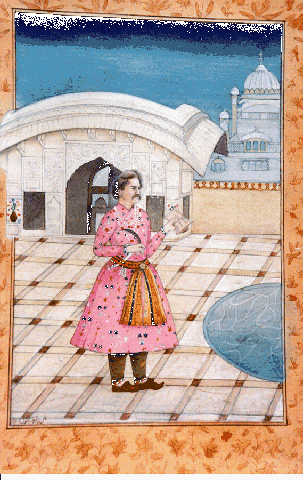Mark Twain in Lahore


From Charles Boewe <cboewe@mindspring.com>:
During the past year the U.S. Information Service in Lahore, Pakistan, encouraged advanced students and recent graduates of the National College of Arts to paint pictures in the manner of Moghul miniatures of events from American history as they might have appeared if they had happened in Pakistan. Among the resulting pictures, one shows "George Washington Crossing the Ravi River" (one of the five rivers of the Punjab, the Ravi has to be crossed to enter Lahore from the west); another shows how the Statue of Liberty would look if located in Faisal Chowk, Lahore; in one Lewis and Clark, along with Sacajawea, are greeted by Indians of the Pacific Northwest--but all have been transported to the Swat Valley; and another depicts Plains Indians on horseback, hunting mountain goats native to northern Pakistan, with Lahore's Badshahi Mosque in the background.
In my opinion the most successful of all is "Mark Twain, in Moghul Clothes, in the Shish Mahal of the Lahore Fort." Since the Fort was one of the tourist sights of Lahore in 1896, when Twain visited there, he probably stood in the very spot shown and, given his love of fancy clothes, he would have enjoyed being dressed like a Moghul king. The Shish Mahal was built in 1631 by Shah Jahan.
There are several other historical ramifications of this picture. Behind the figure of Twain the Naulakha pavilion is well represented. This marble replica of a rural Bengali hut was built at the cost of nine lakhs of rupees (hence its name) by Shah Jahan for Mumtaz, his favorite queen, and she actually lived in it when they were in residence in Lahore--the same queen who now lies buried in the Taj Mahal in Agra. In Moghul history the fanciful Naulakha functioned somewhat like the Versailles dairy farm of Marie Antoinette. To the right of the Naulakha and some distance away can be seen the Samadh of Ranjit Singh, the great Sikh ruler of the Punjab, marking the spot where his body was cremated (along with his wives and concubines and, it is said, a dove that fluttered into the funeral pyre by mistake--a story Twain surely would have enjoyed).
It may be remembered, too, that Twain's friend Rudyard Kipling wrote a novel in collaboration with Wolcott Balestier; the title was misspelled as "The Naulahka." It was Kipling's father who founded the Mayo College of Arts, which has since become Pakistan's National College of Arts.
Having lived in Pakistan ten years, when I read about these paintings being displayed in Islamabad and elsewhere in an exhibition called "Intersections," I asked a friend to mail me a copy of the program notes. These led to correspondence with the American Public Affairs officer in Lahore, who in turn kindly supplied color photos of the miniatures. Above is a GIF image of the Twain picture. Although ancient Moghul miniatures often are by anonymous artists, I should add that this modern miniature was painted by Rabia Kanwal, who specialized in miniature painting at the National College of Arts, where she took her bachelor's degree in 1997. The original painting is for sale, priced at Rs. 16,000.
--Charles